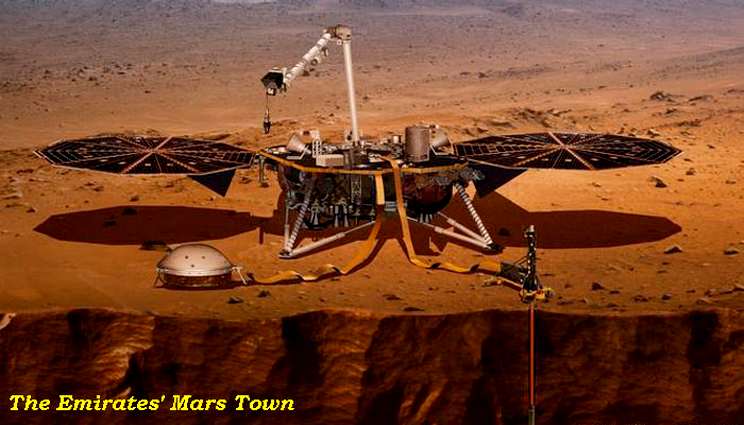
ref:topbtw-2548.html/ 20 Giugno 2020/A

Milano
The UAE is on a 100-year mission to build a city on Mars.
A major first step is its probe called Hope ("Al-Amal"), which launches in July.
It will measure the Red Planet's atmosphere in ways no other probe has before.
Every 18 to 24 months, Earth and Mars align in such a way as to make deep-space travel that little
bit easier, or at least a bit faster.
That reduces a trip or "trajectory" to the Red Planet from about nine months down to seven.
That means that July is shaping up to be a very busy time for missions to Mars.
There are three all launching within days of each other - the Emirates Mars Mission, with its atmospheric probe,
Hope or "Al-Amal," NASA's Mars 2020, carrying a lander called Perseverance, and China's "Tianwen-1", a
collection of orbiters and landers.
In fact, there would have been a fourth mission in Europe's ExoMars 2020.
"If they don't go know, they will have a very long wait," says Malcolm Macdonald, a professor
of space technology at the University of Strathclyde, Glasgow.
"That's why the Americans, for instance, through the current pandemic, prioritized Demo-2, the SpaceX crewed
mission to the International Space Station, and their Mars mission."
How the coronavirus pandemic has affected the Chinese mission is hard to know.
And Europe's ExoMars 2020 was already heading for delays.
As for the Emirates Mars Mission (EMM), failing to leave now would set a 100-year plan for
national - and interplanetary - transformation back by two years.
So, after a round of ultra-fast thinking, which predicted the lockdown and those closed international borders,
the team dispatched its spacecraft, Hope, and a team of Emirati engineers for the
launch in Japan before it was too late.
A sense of urgency
There is a sense of urgency in the UAE that harks back to when the nation was established in 1971, starting from a
point where infrastructure like transport and education were underdeveloped.
It was "evident then that you needed to do things rapidly to get on a par with the world," says Sarah Al-Amiri,
the EMM's Science Lead, in an interview with DW.
Read more:
SpaceX rocket ship blasts off on historic flight to International Space Station
And you can see that in the way the EMM has grown.
The UAE has been developing Earth Observation spacecraft since 2006, which is a short time in itself.
But the Mars mission has gone from a feasibility study in 2013 to its announcement a year later, and now a launch in 2020.
Six short years.
"We don't have a hundred years to sit around and grow organically.
It's always been that way, developing in leaps and bounds," says Al-Amiri.
That culture of rapid growth has been hastened by a dwindling demand for oil.
"There is a drive to diversify," she says.
"And the way to do that is use today's oil, which is knowledge and expertise that's routed in science and technology."
For Al-Amiri and mission manager, Omran Sharaf, seeing UAE's space sector blossom is a long-held passion.
They were perhaps among the more fortunate, being able to study abroad.
But they are back and among the country's pioneers.
Al-Amir says she "never dared to dream of space, just for a lack of existing opportunities" at home, but she
had started programming by the 5th Grade at school, studied computer engineering, and is now UAE's Minister
of State for Advanced Sciences.
Meanwhile, Sharaf says he was always curious about satellites - "I wished I could work on a space program."
He studied electrical engineering in the US, came back to the UAE and joined a team of young Emiratis charged with
setting up that space program.
They started gathering experience in South Korea, working on Earth observation satellites, DubaiSat-1 and 2.
Why not the moon?
It's not only about getting to space.
The mission is designed to establish the UAE's space capabilities
- to encourage homegrown innovation and inspire new generations of scientists, with job prospects and a sustainable future.
As such, it's reasonable to ask, "Why not go to the moon?"
It is closer after all.
The answer lies in the science.
But some other theories suggest Mars may play its own role.
"There are dust storms, cloud formations, water vapor cycles, and we're asking how much impact
that has on the loss of hydrogen and oxygen from Mars into its exosphere," says Al-Amiri.
The mission will do that by taking simultaneous measurements - infrared technology in the lower atmosphere,
where Hope will study temperatures and ice clouds, and ultraviolet technology for the Martian ozone in the
lower atmosphere and hydrogen and oxygen loss in the upper atmosphere.
Finally, there's a simple camera that will enable Hope to take full "disc images" of the planet,
which may reveal "interesting phenomena," says Forget.
"For example, a couple of years ago, we found these elongate clouds forming near the top of Olympus
Mons [the largest volcano on Mars].
They went for 2,000 kilometers, and this had never been seen, because we were always looking at
Mars in strips from the same local time," says Forget.
"So, a full disc image can be spectacular, fun and scientific."
Mission to collaborate
Much has been made of the mission's launching from Japan.
But the Japanese space agency, JAXA, points out that the mission is "UAE's independent program."
Even the launch on a Japanese H-IIA rocket from JAXA's Tanegashima Space Center will be operated not by the
agency but by Mitsubishi Heavy Industries.
But the Japanese connection is interesting to note because Japan has its own interests in Mars.
In an email to DW, JAXA's Nobuyoshi Fujimoto writes that Japan's MMX mission in 2024 will "survey Mars's two moons
and collect a sample from one of them and bring it back."
There is also a good chance that data from the Emirates Mars Mission will flow into Japan's MMX moons mission.
"The Japanese have got fantastic capabilities, but they've never
been to Mars," says Macdonald, "so, working as partners in the international community will give
them more confidence for the next time they decide to go."
( Redazione )

